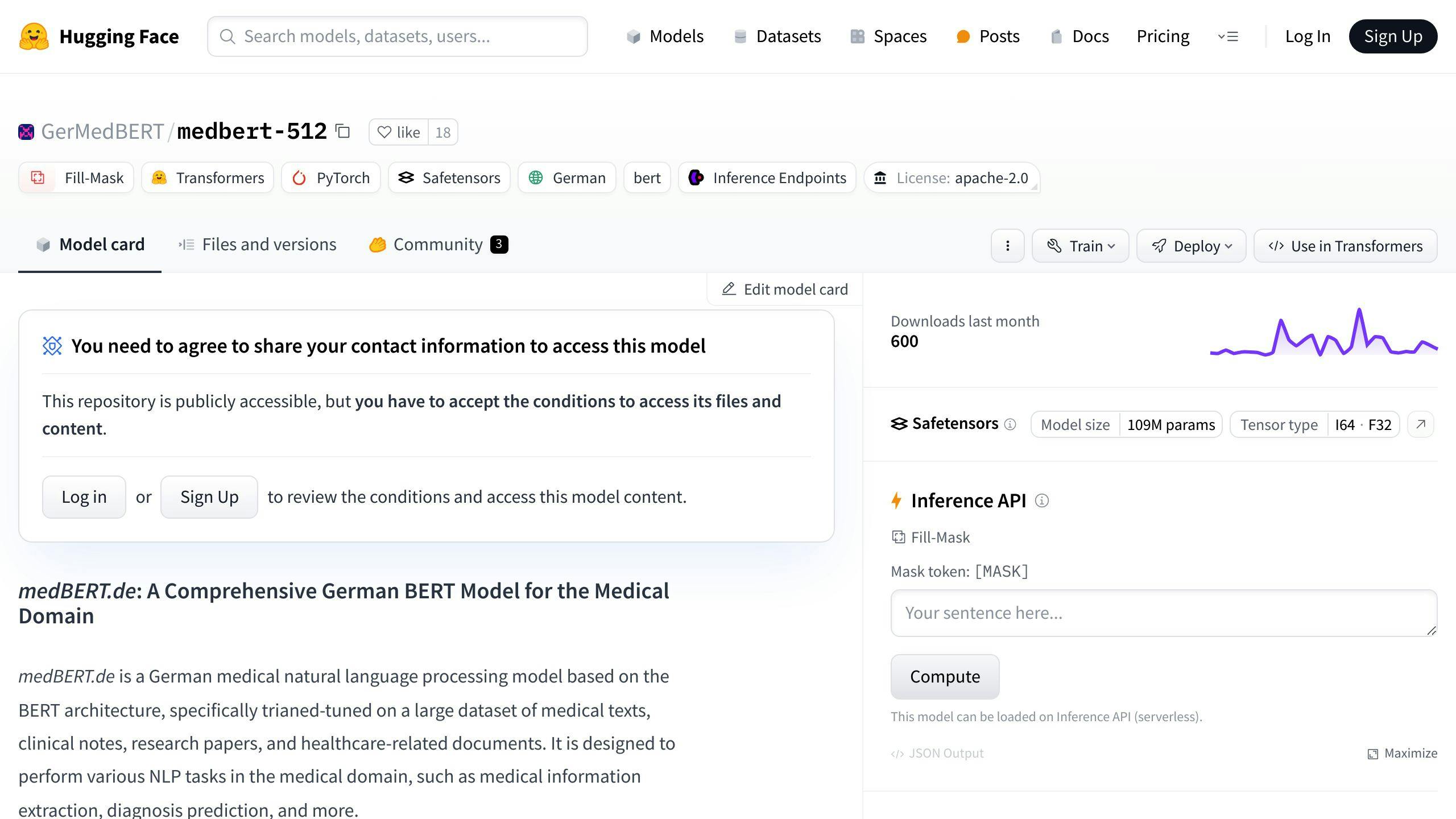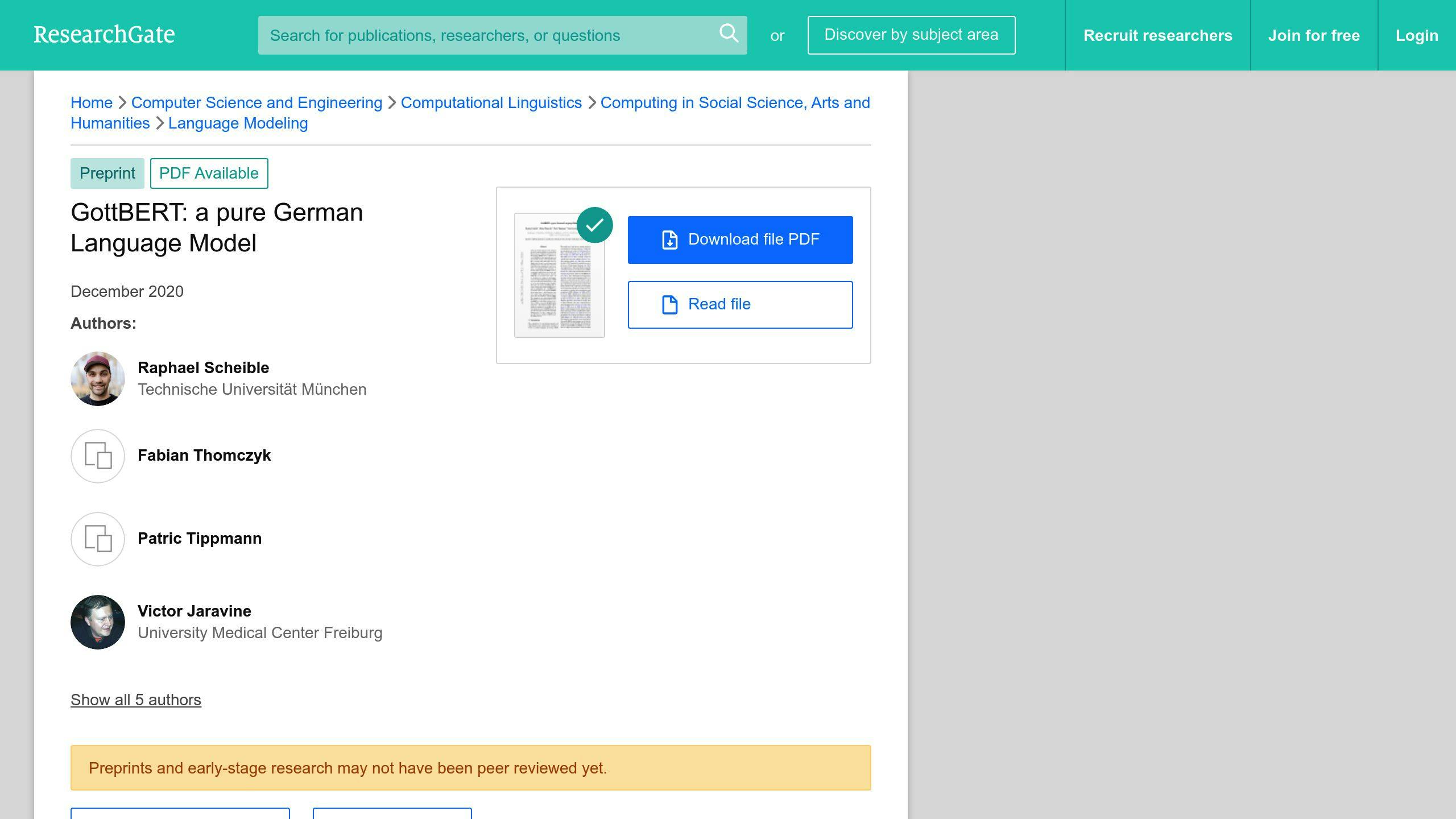German BERT models are state-of-the-art language models designed specifically for processing and understanding the German language. They address the unique complexities of German, such as grammatical structures, compound words, and regional dialects, enabling more accurate natural language processing (NLP) for various applications.
Key German BERT Models:
- medBERT.de: Specialized for the healthcare domain, trained on a large corpus of medical texts, clinical notes, and research papers.
- GottBERT: A monolingual model trained on the OSCAR dataset of German texts, achieving state-of-the-art performance on downstream NLP tasks.
- Legal BERT: Fine-tuned for legal text recognition, particularly named entity recognition (NER) in court decisions and legal documents.
Quick Comparison:
| Model | Training Data | Key Applications |
|---|---|---|
| medBERT.de | Medical texts, clinical notes, research papers | Healthcare NLP, medical research |
| GottBERT | OSCAR dataset of German texts | Text classification, sentiment analysis, language translation |
| Legal BERT | Court decisions, legal texts | Legal text recognition, named entity recognition (NER) |
Developing German BERT models involves overcoming challenges such as acquiring high-quality training data and effective tokenization techniques. The future of German NLP looks promising, with potential applications in industries like legal, customer service, and more, driven by open-source community efforts.
Top German BERT Models
medBERT.de for Healthcare

medBERT.de is a German medical BERT model designed specifically for the healthcare domain. It was trained on a large dataset of medical texts, clinical notes, research papers, and healthcare-related documents. This diverse dataset ensures the model is well-versed in various medical subdomains and can handle a wide range of medical NLP tasks.
Model Architecture
medBERT.de has 12 layers, 768 hidden units per layer, 8 attention heads in each layer, and can process up to 512 tokens in a single input sequence. The model's architecture is based on the standard BERT architecture.
Training Data
| Source | No. Documents | No. Sentences | No. Words | Size (MB) |
|---|---|---|---|---|
| DocCheck Flexikon | 63,840 | 720,404 | 12,299,257 | 92 |
| GGPOnc 1.0 | 4,369 | 66,256 | 1,194,345 | 10 |
| Webcrawl | 11,322 | 635,806 | 9,323,774 | 65 |
| PubMed abstracts | 12,139 | 108,936 | 1,983,752 | 16 |
| Radiology reports | 3,657,801 | 60,839,123 | 520,717,615 | 4,195 |
| Spinger Nature | 257,999 | 14,183,396 | 259,284,884 | 1,986 |
| Electronic health records | 373,421 | 4,603,461 | 69,639,020 | 440 |
| Doctoral theses | 7,486 | 4,665,850 | 90,380,880 | 648 |
| Thieme Publishing Group | 330,994 | 10,445,580 | 186,200,935 | 2,898 |
| Wikipedia | 3,639 | 161,714 | 2,799,787 | 22 |
All training data was completely anonymized, and all patient context was removed.
GottBERT's Monolingual Approach

GottBERT is a German BERT model that takes a monolingual approach to language understanding. It was trained on the OSCAR dataset, which consists of a large corpus of German texts. GottBERT's monolingual approach allows it to focus specifically on the nuances of the German language, making it well-suited for tasks such as text classification, sentiment analysis, and language translation.
Performance
GottBERT's performance on downstream tasks has been impressive, with the model achieving state-of-the-art results in several benchmarks.
Legal Text Recognition with German BERT
The German BERT model has also been fine-tuned for legal text recognition, specifically for named entity recognition (NER) tasks. This model is available on platforms like HuggingFace, making it easily accessible to developers.
Training Data
The legal BERT model was trained on a dataset of court decisions from 2017 and 2018, published online by the Federal Ministry of Justice and Consumer Protection.
Performance
The model's performance on NER tasks has been impressive, with high accuracy rates for identifying entities such as names, locations, and organizations.
Comparing German BERT Models
Several German BERT models have been developed, each with its own strengths and weaknesses. Comparing these models can be challenging, as they have different architectures, training datasets, and performance metrics.
Comparison Table
| Model | Training Data | Performance Metrics | Use Cases |
|---|---|---|---|
| medBERT.de | Medical texts, clinical notes, research papers | High accuracy on medical NLP tasks | Healthcare, medical research |
| GottBERT | OSCAR dataset, German texts | State-of-the-art results on downstream tasks | Text classification, sentiment analysis, language translation |
| Legal BERT | Court decisions, legal texts | High accuracy on NER tasks | Legal text recognition, named entity recognition |
Each German BERT model has its own unique characteristics, making them suitable for different use cases and applications. By understanding the strengths and weaknesses of each model, developers can choose the best model for their specific needs.
Challenges and Solutions
Developing German BERT models comes with its own set of challenges. Let's explore the obstacles and the solutions that have improved their performance.
Data Quality Challenges
Acquiring quality training data is a significant hurdle in developing German BERT models. The data must be diverse, relevant, and free from duplicates to ensure the model learns effectively.
Data Quality Strategies
| Strategy | Description |
|---|---|
| Data deduplication | Remove duplicate entries from the training dataset |
| Filtering | Select specific data points that are most relevant to the task |
| Data augmentation | Generate new data points through techniques like paraphrasing or sentence shuffling |
Tokenization for German BERT
Tokenization is another critical challenge in developing German BERT models. Tokenization involves breaking down text into individual words or subwords, which are then fed into the model for processing.
Tokenization Techniques
| Technique | Description |
|---|---|
| Wordpiece tokenization | Break down words into subwords, which are then represented as individual tokens |
| Subword modeling | Represent each subword as a vector, which is then used to compute the final token representation |
By addressing data quality and tokenization challenges, researchers have been able to develop high-performing German BERT models that can effectively process and understand German language text. These solutions have paved the way for applications in healthcare, law, and other industries where German language processing is critical.
sbb-itb-f3e41df
The Future of German NLP
The German BERT model has opened up new opportunities for natural language processing in the German language. As the technology continues to evolve, we can expect significant advancements in various sectors.
New Applications for German BERT
German BERT models can be fine-tuned for various tasks, such as:
- Legal text recognition: enabling more accurate and efficient processing of legal documents
- Customer service: improving response accuracy and customer satisfaction in chatbots
Open Source and Community Efforts
The development of German BERT models is largely driven by open-source projects and collaborative efforts within the NLP community. As the community continues to grow and contribute to these projects, we can expect further advancements in German BERT technology.
| Project | Description |
|---|---|
| GottBERT | An open-source German BERT model developed by the community |
| German BERT | Another open-source German BERT model with a large community following |
The future of German NLP looks promising, with the potential for German BERT models to revolutionize industries and improve the way we interact with language.
Conclusion
We hope that our work on the German BERT model will help other teams to learn from this process and start making their own non-English models for natural language processing and language understanding. By using our German BERT model, anyone working on implementing NLP for the German language can achieve higher accuracy and better-performing question answering.
In the future, we plan to continue working in this area to improve the model's performance and expand its applications.
Future Plans
| Area | Goal |
|---|---|
| Model Performance | Improve accuracy and efficiency |
| Applications | Expand to more industries and use cases |
We believe that our German BERT model has the potential to revolutionize the way we interact with language and look forward to seeing its impact in the future.